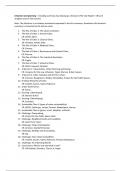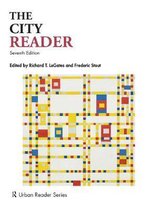Urbanism and planning – including summary, key takeaways, literature (The City Reader= CR) and
imagines used in the lectures.
Note: The literature is not always mentioned separated in the this summary. Sometimes the literature
summary is connected to the lecture notes.
1. The Rise of Cities 1: The urban revolution.
2. The Rise of Cities 2: Ancient Cities.
CR: Childe, Davis.
3. The Rise of Cities 3: Classical Cities.
CR: Aristotle, Fowler, Kitto.
4. The Rise of Cities 4: Medieval Cities.
CR: Pirenne.
5. The Rise of Cities 5: Renaissance and Colonial Cities.
CR: Pirenne.
6. The Rise of Cities 6: The industrial Revolution.
CR: Engels.
7. The Rise of Cities 7: Industrial Cities.
CR: Wirth, Howard, Olmsted.
8. Urbanism 1: Urbanisation, Urban Planning and Desing.
CR: Congress for the new Urbanism, Taylor, Brenner & Keil, Sassen.
9. Urbanism 2: Cities, Suburbia and the Peri-urban.
CR: Fishman, Bruegmann, Wright, UN-Habitat, Project for the Public Spaces.
10. A Global Hierarchy of Cities.
CR: Castells, Sassen, Taylor, Robinson.
11. Urban Governance.
CR: Stone.
12. Housing 1 (developed).
CR: Brenner & Keil.
13. Housing 3 (developing).
CR: Saunders.
14. Sustainable Cities 1 (types of urban sustainability).
CR: WCED, Calthorpe, Jacobs, Putnam, Madanipour, Harvey.
15. Sustainable Cities 2 (green, smart, adaptive, resilient).
16. Challenge: Placemaking.
CR: Project for the Public Space, Gehl.
17. Challenge: Neighbourhoods and Liveability.
CR: Gehl, Perry, Talen.
18. Challenge: Citizen Participation.
CR: Arnstein, Davidoff, Forester.
19. Challenge: Mobility and Accessibility.
CR: Rai.
20. Challenge: Inter-urban Competition.
CR: Castells, Sassen, Taylor, Robinson, Florida, Madanipour.
21. Challenge: An Urbanising World.
22. Conclusions: What’s now and what’s next?
CR: UN-Habitat, Saunders, Tian et al, Angel.
, Notes: Urbanism and planning
Week 1,lecture 1
The “reading and “writing” of cities:
Reading= Looking and understanding of cities.
- We can decipher knowledge from what we observe .
- We can rean read how the city shifts in priorities, power structures, societal values, beliefs
and technological advantages shaped the city.
➔ This is not limited to old cities, also todays structures will say just as much about our
contemporary society.
Writing= Planning of cities.
- Writing a city creates possibilities to shape and transform urban spaces through deliberate
action.
- The organisation and regulation of present and future urban spaces.
- To address collective concerns around spatial issues and the quality of local and regional
environments.
➔ Not only physical but also economic or by laws an regulation (policy).
➔ Involving multiple scales, actors and dimensions.
➔ Mainly from a public planner point of view. But also sometimes private.
The language of cities:
1. Architectural:
= what we see (the style).
= Express ideas, power etc.
= styles are re-used during time, place by civilization.
2. Layout and design of the buildings:
= What do you putt in it → Means: What does the society finds important.
3. Layout and design of the city:
= What is the function of the city now or in the past.
4. Large-scale interventions in the urban fabric: Example: Industrial revolution
=What does interventions do to our cities? →The need for “good conditions”.
5. Shifts in the use of land and buildings →These conditions changed over
6. Power of the city: years. For example: Food conditions.
= Who is changing the conditions?
= Who designed? But: What if the city focuses on one
= Who deals with the consequences? kind of income and the what are the
risks if conditions change.?
Be aware:
- Most attention is paid to palaces and military installations (=powerful buildings).
- But how the common people live tells us much more about the society at large.
,There’re two movements going on influences the language of cities, but are the opposite:
1. Adaption to global warming.
2. Heritage protection.
Example: The zinc roof tops in Paris which are causing the high temperatures in the city.
Result: “new” language which is modern and worldwide= international planning.
The Urban Revolution:
= The change to another state which is totally different from the first state.
= Humans adapt to the new conditions (biologically).
= These are small and independent changes over a long time period, on different places.
= Happens with the same forces/conditions with outcome: “The city will happen”.
Every event starts a “new time”= subjective= period of changes with the same conditions.
Conditions can be: Climate, use of animals, types of wheat etc.
From hunter-gather societies to the first permanent settlements:
• Stable food supplies=food security.
• Peace.
• Fertile soil.
→The revolution to permanent settlements was not a stable/linear movement, but experimental.
→How earlier this process started, how earlier the urban revolution started.
Very Gordon Childe:
= most knows for proposing to view human history in terms of revolutions (agriculture, urban,
industrial) instead of the three age system (stone, bronze, iron).
= 10 conditions which leads to cities.
12.000 years ago: Tribes settled down parentally duo to fertile soil.
• Relation purpose.
• Economic purpose.
, Community= personal, you know each other (tribes).
Society= less personal, you need more structure to let it work: Someone with power, plan things=
institutional.
What changed during the agricultural revolution:
- Communities could grow to become societies duo to food surplus and food security.
- Population growth and animal husbandry (for food and power).
- Large changes in livelihoods meant large changes in organisation of society, economy,
tradition and belief system.
The first urban settlements: (Mesopotamia= between rivers)
- Climate. Pro-urban, not all of the conditions, but the need
- Colonialization. for planning and rules.
1. What defines an urban environment?
- Different conditions than non-urban, but it is not black-white.
- Scale changed: Personal or not?
- The way you live, eat, sleep etc.
2. What defines an urban economy?
- Diversity and specialists: No longer good in everything, but the first professions.
- First: Needed money and food to get specialists.
- What is more important? Earns more money or more valued.
- How longer in years→ More steps in the process and even more specialists: Who is good in
which step= society became more complex!
Results in:
3. What defines an urban society?
- Stratification/classes/layers in populations and in professions.
4. What defines an urban civilisation?
- Cities working together and specialise themselves within a network.
- Conditions for the city depends on other cities.
Gordon Childe:
Urban revolution= the shift from relatively simple, re-urban communities and village-based
agricultural production to the complex social economic a political systems in the earlies cities.
Important for Childe: The development of writing was one of the crucial cultural elements of true
urbanism.
Week 1,lecture 2
Urbanism as a process:
Density, building into the sky. Process towards something.
Last year’s process: Informal building like slums.
But:
- Where is the border of the city?
- Can we compare these “rules” worldwide?
Definition of urbanism= Increasing population in the city compared to rural areas: So not when they
growth in the same number. So a city can not urbanize.






